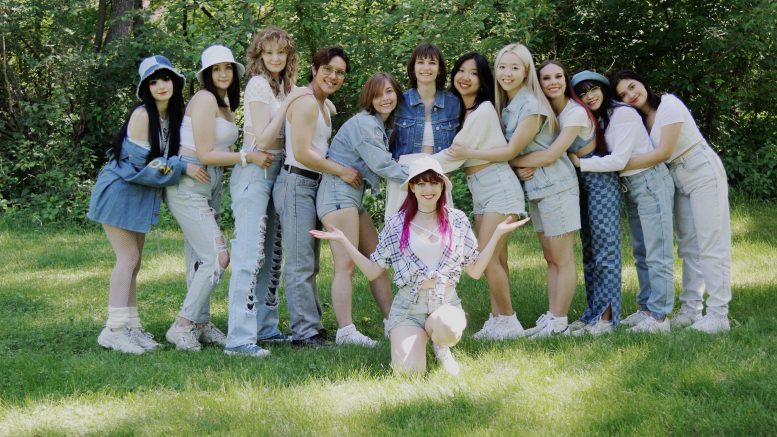K-pop, or Korean popular music, is a multi-genre music scene mostly made up of idol groups — idols being the industry term for K-pop stars — that has found immense popularity outside of its South Korean origins.
K-pop has no single sound to it, as K-pop hits range from the chiming bubblegum pop of girl group Twice to the broody electronic noisiness of boy group NCT. Even then, groups veer off-brand all the time.
The scene has evolved in waves, with the earliest iterations of what is now known as K-pop taking shape in the ’90s. Each of these waves is referred to as a generation, with the newest groups comprising the fourth generation.
U of M Korean language instructor Hyekyung Song recalls ’90s boy group Seo Taiji and Boys pioneering K-pop. The group was among the first K-pop artists to bring hip-hop influences into their styles.
K-pop songs do not have to be performed in Korean to qualify as K-pop. Many K-pop songs are partially, or entirely, in English. Song explained that the inclusion of English lyrics is partly a product of globalization and partly due to artists’ desires to communicate with wider audiences.
“They want to share their stories, experiences with others, surpassing language barriers,” she said.
Song said that many of her students are led to engage with aspects of Korean culture such as Korean television, films and food due to their interest in K-pop.
Ultimately, though, Song thinks that “K-pop is still in the centre” of her students’ interests.
The K-pop fandom has unique characteristics. New groups are referred to as “rookies,” and fans of particular groups refer to themselves with special monikers. Fans of girl group BLACKPINK are Blinks, fans of Twice are Onces and BTS fans are known as ARMY.
Many K-pop fans are so dedicated, they will learn multiple choreographies for their favourite songs or groups, and Winnipeg’s corner of K-pop fandom is rapidly expanding.
One of the longest running K-pop dance cover group in the city is Galax-E, founded in 2017.
Camryn Neufeld, a student at the U of M, and Jenna Brown, are dancers and administrative members of Galax-E.
Some organizations around the city, such as the Asian Heritage Society of Manitoba, have started to introduce K-pop dance competitions. However, Brown explained that Galax-E aims to be “laid-back” rather than competitive.
Neufeld and Brown said that K-pop groups hook fandoms through more than just their catchy music. K-pop groups’ music videos often have story components and high production value.
One example is BLACKPINK’s music video for its song “DDU-DU DDU-DU.” The music video has over two billion views on YouTube and features gaudy visuals in pink palatial sets, including a famous shot of one member Jennie perched on a bedazzled tank.
Aesthetics are not the sole appeal, according to Neufeld. Idols create strong connections with their fans by crediting them with their successes. Fans will learn K-pop choreographies to feel connected to other fans too.
“Not only does [learning a dance] connect to the idols, but it also connects to the community because then everybody’s like, ‘oh my God, this song is amazing, let’s learn it and post videos,’” Neufeld said.
Brown explained that fans are so dedicated that Drop In Dance Winnipeg attracts beginners and seasoned dancers alike with its K-pop dance classes.
“People who do it like we do, where we actually do it on stage, and people who just want to do it for fun because they love the song or they love the artist, they show up,” she said.
While K-pop cover dance teams like Galax-E have featured at events like Ai-Kon Dream Stage, the recent launch of K-pop Club Nights at the Rec Room has provided dedicated spaces for K-pop fans to connect over their shared interest.
There is no single reason why the K-pop fandom has seen such explosive growth in recent years.
Dana Lance is one of the co-founders of a K-pop dance team in Winnipeg established in 2017 called Illicit. She also believes that part of the draw to learning K-pop choreography is that “everyone else knows it.”
Because K-pop pulls from hip-hop and other music genres pioneered by Black communities, some K-pop groups have been criticized for appropriating elements of dance originating in Black communities.
Lance’s extensive background in music and dance led her to K-pop. She said that she sees value in K-pop cover dancers learning directly from original choreographers.
“Being exposed to the overall dance community, I think, will be another gap into bridging more connections,” Lance said.
“I think K-pop dance cover crews can learn a lot from learning dance styles like hip-hop and Waacking and voguing, and just being able to improve the quality of their performance,” she said.
“As we’re growing in this scene, I think it’ll be going toward this shift where we’ll have to recognize that.”
More information on Illicit and Galax-E’s performance schedules are available on their Instagram pages at @galaxeofficial and @illicitdancecrew.


